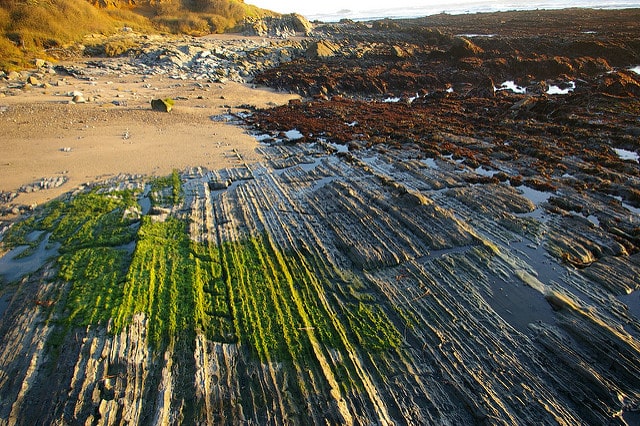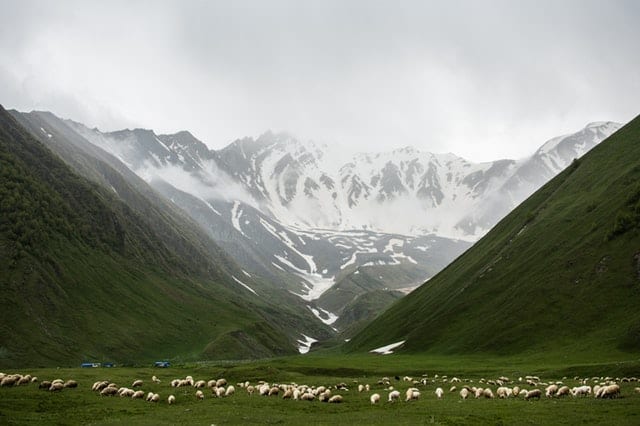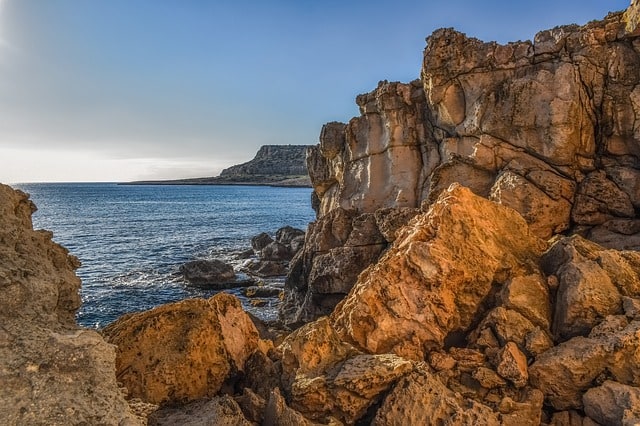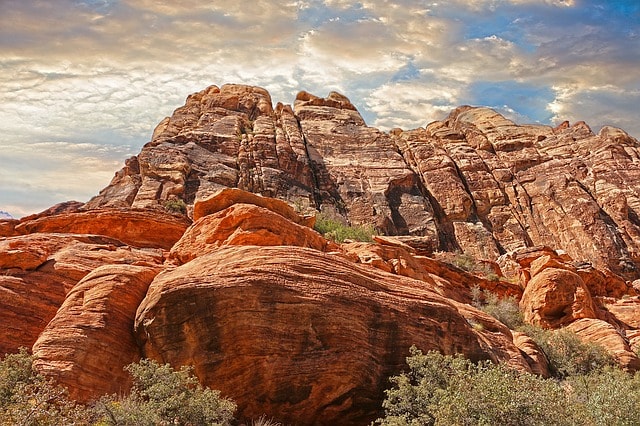Quartzite – Formation, Composition, Properties, and Uses

Quartzite (from German Quarzit) forms when quartz sandstones are metamorphosed. The term quartzite also implies its high quartz content. Most quartzites contain 90% quartz by volume, but the percentage can go up to 99% in the case of the purest quartzite forms.
Quartzite looks similar to its parent rock but it is much harder than sandstone. The best way to tell quartzite from sandstone – break it.
The sandstone breaks mostly around the individual sand grains of which it is made, while quartzite breaks them. In quartzite, the grains are much more firmly cemented by silica, to the point where the individual grains lose their structural identity.
How Quartzite Forms?
Quartzite forms when pure or nearly pure quartz sandstone undergoes intense heating and pressure usually related to tectonic compression.
Geologically speaking, quartzite formation involves two types of metamorphisms: contact and Barrovian. Quartzite can form by either or both of these processes.
1. Barrovian metamorphism – it happens during massive tectonic events that give birth to high mountains. When massive continental plates collide, the resulting compressional force will be extreme that it will squeeze, push, and crush the sandstones.
During this process, quartzite becomes banded in an interlocking mosaic of quartz, feldspar, biotite, and amphibole.
2. Contact Metamorphism – When magma comes in contact with sandstones, they get baked and fuse so tightly that the sand grains lose their clastic structure.
As a rule of thumb, the deeper and hotter the sandstone gets, the more firmly it’s fused. The minerals crystallize together and finally become quartzite. This is somewhat similar to the conversion of snow to glacial ice.
Major changes that occur during sandstone metamorphism into quartzite:
- Loss of all or most of the original sedimentary particles, texture, and structure of the sandstone
- Conversion of the super grainy, sandpaper-like surface into a glassy one.
- Migration of former cementing materials (iron oxide, silica, carbonate, and clay) during crystallization. These are considered ‘impurities’ and are the reason for different colors of quartzite.
- Formation of veining patterns within the quartzite.
Since the transition from sandstone to quartzite is gradual, some geologists suggest an intermediate rock called Quartz arenite. However, it is hard to pin down the exact moment that sandstone becomes quartz arenite or quartzite. Why? Because the temperature and pressure behind the metamorphism are not definitive.
Composition of Quartzite
The name itself says it is entirely of quartz. Quartzite’ mineralogical profile looks like this:
- SiO2 – Min. 97%
- AL2O3 – Max. 1%
- Na2O + K2O – Max. 0.02%
- Size – 10 – 40 MM
- Moisture – Max 2%
If the percentage of quartz is about 99%, it is known as orthquartzite. Alongside well-rounded quartz grains cemented by silica, orthoquartzite also has traces of iron oxide, zircon, rutile, and magnetite. Example: Cambrian Stiperstones hill in Shropshire, UK.
Vivid selection of colors in quartzite
Being a natural stone, quartzite is often found in whites and greys, with occasional beiges becoming its base color. However, the stone’s true beauty is found in a spectrum of colors patterned throughout. When iron oxides and other minerals dominate, quartzite takes shades of pinks and reds, blends of blues and yellows, and sea green.
Some quartzites come in purple, brown, and black — all thanks to different minerals that were around when sandstone was undergoing metamorphosis.
Characteristics and Properties of quartzite
- Hardness: Quartzite contains more quartz – about 90 to 99% – giving it a hardness of 7 the Mohs Hardness Scale. Meaning quartzite is extremely harder – the reason why it is often used as a railway ballast.
- Acid Resistance: Quartzite is completely resistant to acidic; it will not etch from lemon juice, vinegar, or any other acidic food.
- Porosity: Quartzite has varying levels of porosity with a few varieties being less porous, while some being relatively more porous. This is because certain areas of the sandstone, the more porous parent stone, may or may not have metamorphosed to the same extent as the rest of the stone. Meaning, chances are that some quartzites may retain the porous nature. For example, highly metamorphosed Taj Mahal quartzite and more porous Calacatta Macaubas Quartzite.
- Heat resistance: High temperatures helped quartzite form and, it is relatively heat resistant. When exposed to heat, quartzite doesn’t crack or sustain other damage.
- Durability: Quartz can withstand wear and tear very well.
Where to Find Quartzite?
Quartzite forms at convergent tectonic plate boundaries, the regions where two tectonic plates collide, often causing one plate to slide below the other (a process geologists called subduction).The quartzite is abundant in mountain ranges of subduction zones.
Geological distribution of quartzite across the world
United States: Quartzite occurs throughout the US: Pennsylvania, eastern South Dakota, southwestern Minnesota, the Wasatch Range of Utah, the Baraboo Range of Wisconsin, Central Texas, and near Washington, D.C. The town of Quartzite in Arizona takes its name from quartzite in the mountains of Arizona.
United Kingdom: In the UK, you can find Precambrian and early Ordovician quartzite crags and cliffs in south Shropshire, Nuneaton town, Holyhead mountain of Wales, and Holy island off Anglesey.
Brazil: Brazilian states of Bahia, Espírito Santo, Minas Gerais, São Paulo, Ceará, and Pernambuco are where the world’s most exquisite and colorful quartzites present. Fusion Wow, Emerald Green, and Explosion Blue are popular among Brazil quartzites.
Africa: The African plate is one of the major tectonic plates on earth and has metamorphic rocks of 3.6 to 2.6 billion years old. That also means Africa has more quartzite than we can imagine.
Eastern and Volta region of Ghana, Monte Binga in the Chimanimani Mountains, coastal town of Hermanus, South Africa, Lukenya Hill, and Kisio Rockshelter in East Africa are all popular regions with Precambrian quartzite. A new addition to this list is Anjouan island, off the eastern coast of Africa.
Europe: Numerous regionally isolated quartzite deposits are found in continental Europe. Rhenish Massif of Germany, Nilsia quartzite deposit of Finland, Taunus and Harz mountains of Germany, Świętokrzyskie Mountains of Poland, etc are some of the important names to remember.
Canada: The La Cloche Mountains in Ontario are full of white quartzite.
Cambrian and Precambrian quartzites are also found in, the Rhenish Massif in Continental Europe, Foinaven and Arkle Mountains in Scotland, and Mount Errigal in Ireland.
Uses of Quartzite
Quartzite’s unique properties lend itself to many uses. Read on for some perhaps surprising uses of quartzite.
Architecture, decoration, and interior design – These days, quartzite is well-considered in architecture, decoration, and interior design for its strength, toughness, elegant marble patterns.
Quartzite does stand up better to stains, abrasion, and heat -meaning it’s a perfect stone to bring life to floors, elegant kitchen countertops, decorative walls, and garden pathways. As a decorative stone, it is used to cover walls, pools, garden pathways, backyards, or stair treads.
Construction – Quartzite has high abrasion resistance and durability so it’s a popular stone in the construction industry. It is used as road aggregate and concrete aggregate.
It is also used to construct retaining walls, rubble masonry, stone pitching, and even tombstones. Owing to its hardness and angular shape, crushed quartzite is used for railway ballast.
Abrasive – A good abrasive is not just hard, but also tough and sharp. Since quartzite shares these attributes, it is considered a good sanding and polishing abrasive.
Jewelry – Glossy look and vivid colors increased its demand in custom, handmade jewelry and sculpture making. Cut and polished quartzite necklace, ring, or bracelet go with every outfit.
Crystal Healing Stone – Quartzite is a popular stone in crystal healing. It is said to be associated with balancing positive energy, awakening, purification, and achievement.
Waterway embankments – Quartzite is used on embankments to prevent soil erosion.
Lubricant productions – Silicone, the major element present in quartzite, is used for making lubricants and waterproofing materials.
Manufacturing industry – Quartzite has a high concentration of silica. Therefore, it has high demand in the manufacturing industry where silica is used. For example, ferrosilicon, manganese ferrosilicon, silicon metal, and silicon carbide manufacturing.
Glassmaking – It is one of the primary uses of quartzites. Glass is manufactured from a chemical compound known as Silica dioxide (SiO2), the major component in quartzite. This silica dioxide is then melted and allowed to cool down into the desired shape or dimension.
Flint alternative – During the Stone Age, quartzite was believed to be used as an alternative to flint.
Lastly, remember not to be confused with ‘Quartz’
Quartzite is a natural metamorphic rock, while quartz is an igneous rock cooled and crystallized from magma or precipitated around hydrothermal vents.
Sandstone under high pressure becomes quartzite, but quartzite does not become quartz.
The construction industry brings further mix up the matter. ‘Quartz” for countertops, is an engineered stone with approximately 90 -93% quartz mineral, 7-10% resins, and traces of pigments.
References:
https://link.springer.com/article/10.1007/BF02767848
https://www.sciencedirect.com/topics/earth-and-planetary-sciences/quartzite






